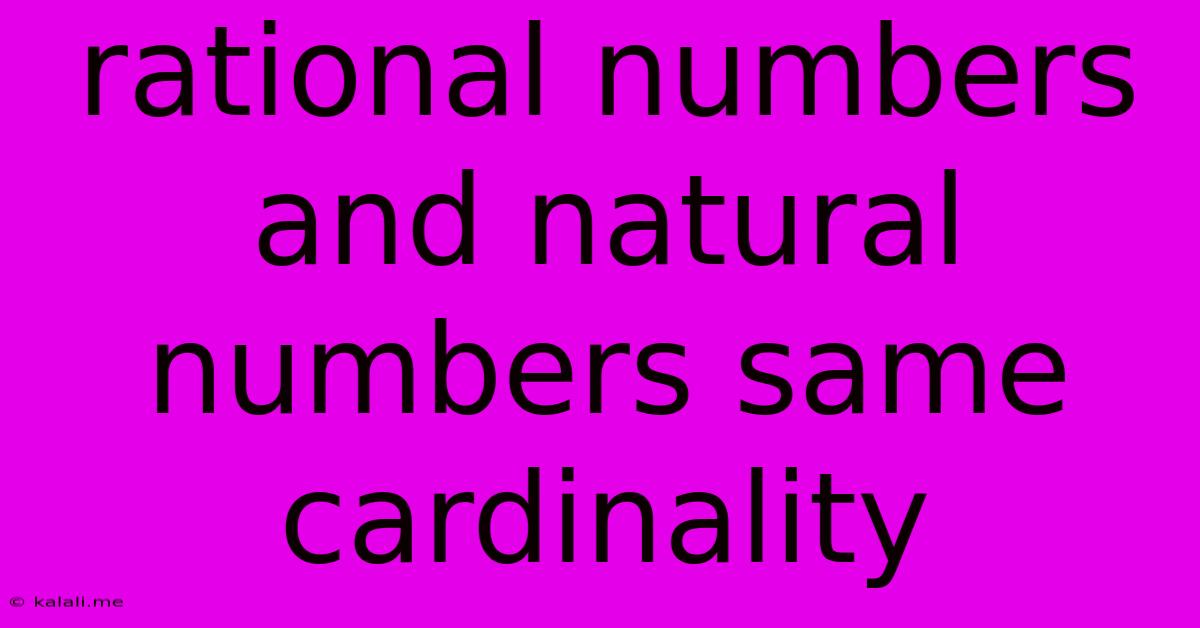Rational Numbers And Natural Numbers Same Cardinality
Kalali
May 23, 2025 · 3 min read

Table of Contents
Rational Numbers and Natural Numbers: Surprisingly, They Have the Same Cardinality!
Meta Description: Discover the fascinating proof that rational numbers, despite appearing infinitely denser than natural numbers, actually share the same cardinality – a concept explored through Cantor's diagonal argument and its implications.
The world of infinity is full of surprises. One of the most counterintuitive is the fact that the set of rational numbers (ℚ) and the set of natural numbers (ℕ) have the same cardinality. This means that despite the seemingly infinite density of rational numbers between any two natural numbers, there's a one-to-one correspondence between these two sets. This might seem impossible at first glance, but a clever proof elegantly demonstrates this surprising truth.
Understanding Cardinality
Before diving into the proof, let's clarify what cardinality means. Cardinality refers to the "size" of a set. For finite sets, it's simply the number of elements. For infinite sets, it's a bit more nuanced. Two infinite sets have the same cardinality if there exists a bijection – a one-to-one and onto mapping – between them. In simpler terms, you can pair up every element in one set with a unique element in the other set without leaving any elements unpaired.
The Proof: Visualizing the Rational Numbers
The most common method to demonstrate the equal cardinality of ℚ and ℕ involves a clever arrangement of the rational numbers. We can't simply list them sequentially because they are densely packed (between any two rational numbers, there are infinitely many others). Instead, we arrange them in a grid.
Consider a grid where each row represents a numerator and each column represents a denominator. The entry at row m and column n represents the rational number m/n. We exclude entries where n is 0 to avoid division by zero.
1/1 1/2 1/3 1/4 ...
2/1 2/2 2/3 2/4 ...
3/1 3/2 3/3 3/4 ...
4/1 4/2 4/3 4/4 ...
...
Now, we can systematically traverse this grid, creating a sequence that includes every positive rational number:
1/1, 1/2, 2/1, 1/3, 3/1, 2/2, 1/4, 4/1, 3/2, 2/3, 1/5...
This sequence, although containing repetitions (e.g., 2/2 = 1/1), covers all positive rational numbers. We can easily modify this to incorporate negative rational numbers and zero.
Creating a Bijection
By eliminating repetitions and systematically ordering the rational numbers as shown above, we have effectively created a sequence that can be mapped one-to-one with the natural numbers. This demonstrates the existence of a bijection between ℚ and ℕ. Each rational number is assigned a unique natural number as its position in this sequence.
Cantor's Diagonal Argument and its Implications
While this grid method demonstrates the countable nature of rational numbers, it's important to contrast this with the uncountability of real numbers (ℝ), proven by Cantor's diagonal argument. This highlights a crucial difference in the sizes of these infinite sets, showing that not all infinities are equal. The cardinality of ℕ and ℚ is denoted as ℵ₀ (aleph-null), while the cardinality of ℝ is a larger infinity, ℵ₁ (aleph-one).
Conclusion: The Power of Infinite Sets
The fact that rational numbers and natural numbers have the same cardinality reveals the surprising intricacies of infinite sets. It challenges our intuitive understanding of "size" when dealing with infinity. While it may seem paradoxical at first, understanding this concept provides a foundational understanding of set theory and its applications across various mathematical fields. The proof highlights the power of systematic approaches in dealing with seemingly infinite and densely packed sets, reminding us that even in the realm of infinity, order and structure can prevail.
Latest Posts
Latest Posts
-
How Many Grams Of Sugar In A Pound
Jul 12, 2025
-
7am To 11am Is How Many Hours
Jul 12, 2025
-
If Your 35 What Year Was You Born
Jul 12, 2025
-
How Many Cups Is 1 Pound Of Cheese
Jul 12, 2025
-
30 X 30 Is How Many Square Feet
Jul 12, 2025
Related Post
Thank you for visiting our website which covers about Rational Numbers And Natural Numbers Same Cardinality . We hope the information provided has been useful to you. Feel free to contact us if you have any questions or need further assistance. See you next time and don't miss to bookmark.